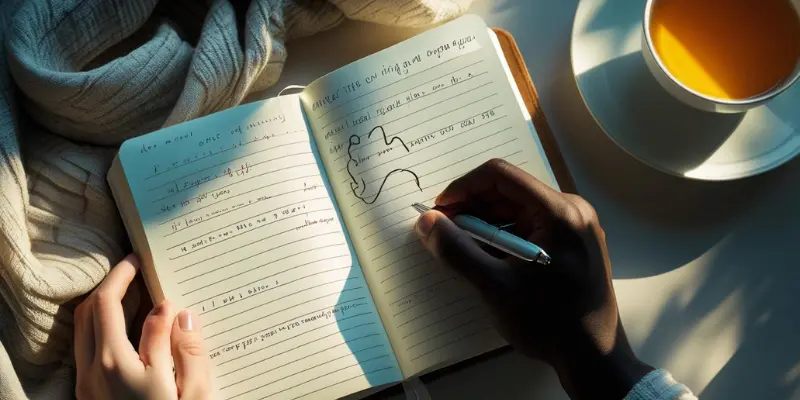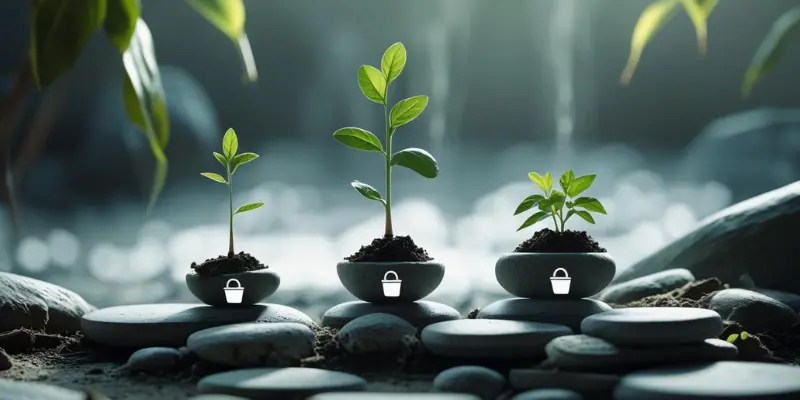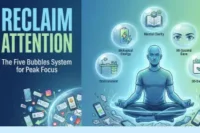How to Build Your Emotional First-Aid Kit: 7 Essential Tools for High-Stress Days
Published: 11/07/2025
Picture this: It’s one of those overwhelming days where everything feels like it’s piling up. Your work is never-ending, your to-do list is growing, and your mind races, trying to keep up with the pressure. Perhaps you feel emotionally “injured”—a sense of frustration, anxiety, or even anger, but you’re not sure how to address it. It’s not a physical injury, but the emotional toll is real. Sound familiar?
Just like a cut or bruise, if emotional challenges are left unattended, they can quickly escalate. Over time, the emotional “wounds” you ignore will fester, affecting your mood, mental health, and even physical well-being. When you don’t have the tools to manage stress, anxiety, or frustration, it can spiral out of control—just as a physical injury worsens without proper care.
Imagine if, instead of waiting for emotional distress to take over, you had a personalized toolkit ready to help you navigate these high-stress days. That’s where the Emotional First-Aid Kit comes in. It’s a proactive, intentional collection of resources designed to support your emotional health in real time—when you need it most.
In this guide, you’ll discover how to build your own Emotional First-Aid Kit. You’ll learn how to stay calm, resilient, and regain control during high-stress moments. This toolkit will give you practical strategies for emotional support, helping you stay grounded and in control, no matter what life throws at you.
This guide will walk you through the process of crafting your personalized Emotional First-Aid Kit, featuring 7 essential tools to help you navigate and overcome moments of emotional overwhelm.
What Exactly Is Your Emotional First-Aid Kit?
Your Emotional First-Aid Kit is a personalized collection of resources, strategies, and comforts designed to help you manage immediate emotional distress. It’s like a first-aid kit for your mind and feelings—something you can turn to when you’re feeling overwhelmed, anxious, or emotionally drained. Just as you would reach for a band-aid when you get a cut, your Emotional First-Aid Kit provides the tools to quickly address and relieve your emotional “wounds.”
Think of it as a proactive emotional support system—an organized collection of your favorite calming practices, comfort items, and coping strategies. It’s about being prepared for emotional challenges, just like having an umbrella ready when it rains.
Why You Need This Kit (Beyond Coping)
- Proactive Self-Care: This isn’t just about reacting to emotional distress—it’s about building emotional resilience. Your Emotional First-Aid Kit empowers you to handle stress before it gets overwhelming, preventing emotional burnout and promoting ongoing well-being.
- Preventing Overwhelm: Having your kit on hand means you’re prepared to de-escalate emotional situations before they spiral into full-blown crises. Instead of waiting until you feel overwhelmed, your kit helps you manage stress from the start.
- Empowerment: The tools in your kit give you control over your emotions. Rather than feeling at the mercy of stress, anxiety, or anger, you can proactively manage your emotional responses and regain a sense of control.
- Daily Wellness: Your Emotional First-Aid Kit is not just for emergencies—it’s an ongoing support system for daily emotional well-being. By using it regularly, you develop healthier emotional habits and strengthen your ability to cope with everyday stressors.
The Blueprint: Your Step-by-Step Guide to Building Your Kit
To build an effective Emotional First-Aid Kit, the first step is understanding your unique emotional landscape. This means knowing what triggers your stress and anxiety, recognizing the physical and mental signs of stress, and reflecting on what has helped you cope in the past. Personalizing your kit begins with this deep understanding.
- Identify Triggers
The first part of your emotional landscape is understanding what causes your stress or anxiety. Are there specific situations or thoughts that tend to set you off? For some, it might be deadlines at work, social interactions, or consuming specific news. For others, it could be unresolved conflicts or unexpected changes. Write down a list of common stressors, so you know exactly what situations are likely to require your kit. - Recognize Your Signs
Stress doesn’t always look the same for everyone, so recognizing how stress manifests for you is key. Some people experience racing thoughts, while others may notice muscle tension or become irritable. Stress might also lead you to withdraw socially or feel an overwhelming sense of frustration. Take note of how your body and mind react when you’re under pressure so that you can be prepared to address it as soon as those signs appear. - Reflect on Past Coping
Think about what has genuinely helped you feel better during times of stress in the past. Have certain activities, objects, or routines provided comfort or relief? Maybe it’s taking a short walk, listening to a soothing playlist, or reading a favorite book. Even small things can make a big difference. By reflecting on what’s worked for you, you’ll be better able to include those coping strategies in your kit.

Choosing Your “Container” (Physical or Digital)
Once you’ve understood your emotional landscape, the next step is to choose a container for your Emotional First-Aid Kit. The container is the place where all your tools, strategies, and resources will be stored—so it should be accessible and easy to use when you need it.
- Physical Kit Ideas
If you prefer something tangible, choose a physical container. It could be a small box, a dedicated drawer, or even a backpack—something that’s easy to grab when you need it most. Keep it in a place that’s easily accessible, whether at your desk, by your bedside, or in your bag. This way, you can reach for your kit without delay in stressful moments. - Digital Kit Ideas
If you’re more inclined to use digital tools, consider creating a digital kit. A simple option could be a phone folder with apps for meditation, journaling, or stress relief. You could also use a cloud drive folder to store guided audio, breathing exercises, or mood trackers. A specific app designed for emotional well-being (such as Calm, Headspace, or Insight Timer) can be a great addition. Having these resources at your fingertips ensures you can deploy your kit even on the go.
The Golden Rule: Personalization is Power
There’s no one-size-fits-all when it comes to building an Emotional First-Aid Kit. The key to making it truly effective is personalization. Your kit must be tailored to your unique needs, preferences, and emotional triggers. What works for someone else might not work for you—and that’s perfectly fine.
- Customize Your Tools
For example, you might find that mindfulness works wonders for you, while others may find comfort in physical activities like stretching. Some people may need calming items like scented oils, while others might prefer reading positive affirmations. The idea is to build a kit that speaks directly to your emotional needs. Think about what has helped you in the past, and don’t hesitate to experiment with new tools that resonate with you. - Adapt as You Grow
Your emotional needs will evolve over time. What worked for you a year ago might not be effective today, and that’s okay. Regularly update your kit with tools that align with your current emotional state. Over time, you’ll refine your kit, adding what works and removing what doesn’t. The personalization of your kit is what makes it a powerful tool for emotional resilience.
7 Essential Tools to Include in Your Emotional First-Aid Kit
Each of the 7 tools featured in your Emotional First-Aid Kit is designed to help you manage stress, anxiety, and overwhelm in real-time. These tools serve as immediate relief strategies, empowering you to handle emotional challenges effectively. Below, we’ll walk through what each tool is, why it’s effective, and how to include it in your kit for optimal results.
Mindful Moments & Grounding Techniques
- What: Mindful moments and grounding techniques include short guided meditations, deep breathing exercises, and sensory exercises (e.g., 5-4-3-2-1). These practices bring you back to the present moment, helping calm your mind and body during stressful situations.
- Why it’s effective: Mindfulness and grounding techniques activate the body’s relaxation response, reducing stress and anxiety in moments of high tension. Deep breathing, for example, slows your heart rate and calms the nervous system, while the 5-4-3-2-1 sensory exercise helps anchor you in the present by focusing on your surroundings.
- How to Include:
- Guided Audio: Include links to short, calming meditation tracks or apps like Calm or Headspace.
- Breathing Guides: Print out simple guides for breathing exercises like 4-7-8 breathing or box breathing.
- Focus Object: Carry a small object like a stone, crystal, or keychain to help you ground yourself during moments of stress.

Sensory Soothers & Comfort Items
- What: Sensory soothers are items that engage your senses (touch, smell, taste, sight, or sound) to provide comfort and relaxation. These might include things like essential oils, comforting teas, or a favorite playlist.
- Why it’s effective: Engaging your senses creates an instant soothing effect, grounding you and helping to reduce emotional tension. Certain scents (like lavender or chamomile) have calming properties, while a favorite song can trigger positive memories, lifting your mood.
- How to Include:
- Essential Oil Roller: Keep a small rollerball of lavender or peppermint oil in your kit.
- Comforting Tea: Add herbal tea bags (e.g., chamomile, peppermint) that you can brew for relaxation.
- Soft Fabric: A small, comforting piece of fabric (like a swatch of your favorite blanket) can offer tactile comfort.
- Music Playlist: Create a soothing playlist of calming or familiar songs that provide emotional comfort.
Distraction & Engaging Activities
- What: Engaging activities like puzzles, coloring, or reading can provide an important distraction from overwhelming thoughts. These activities help shift your focus away from stress and give you a mental break.
- Why it’s effective: Engaging in an absorbing task shifts your focus from emotional distress, helping your mind relax and reset. These activities provide a mental break, giving you the space to recover before re-engaging with the situation.
- How to Include:
- Small Puzzle: A pocket-sized puzzle or brainteaser can help take your mind off stress.
- Mini Sketchbook/Coloring Book: Include a small coloring book or a sketchbook with a set of colored pencils to express creativity and calm your mind.
- Lighthearted Videos: Keep a list of your favorite funny or lighthearted YouTube videos or a playlist of short episodes that lift your mood.
- Short Story or Poem: Include a favorite short story or poem that makes you smile or helps you relax.
Connection & Support Reminders
- What: These are items that remind you of your support network, combating feelings of isolation and loneliness. Having tangible reminders of loved ones or supportive messages can help you feel connected, even in moments of emotional distress.
- Why it’s effective: Social support is one of the most important factors in emotional resilience. These reminders help reduce feelings of isolation and provide you with comforting thoughts, reassuring you that you are supported.
- How to Include:
- List of Trusted Contacts: Write down a list of people to reach out to, with a note on who to contact for different emotional needs.
- Photos of Loved Ones: Include small photos of friends, family, or pets that bring you comfort.
- Letters or Messages: Keep a letter from a friend or inspiring messages that you can read when you need support.
Self-Reflection & Processing Tools
- What: These tools help you acknowledge and process your emotions. They include journaling prompts, mood trackers, and emotional charts like a feeling wheel, which help identify and label your feelings in a safe, productive way.
- Why it’s effective: Writing or reflecting on your emotions is a key part of emotional processing. These tools allow you to express what you’re feeling without judgment, helping you gain clarity and understanding.
- How to Include:
- Small Journal & Pen: Include a journal for writing down your thoughts and emotions.
- Journaling Prompts: Print a list of simple, actionable prompts to get started (e.g., “What is one thing that made me happy today?”).
- Mood Tracker: Add a mood tracker sheet to monitor your emotional shifts.
- Feeling Wheel Printout: Include a feeling wheel to help you identify and describe your emotions more easily.

Movement & Physical Release
- What: Physical activities help release tension and shift energy, whether it’s stretching, dancing, or even squeezing a stress ball. Movement can act as an emotional release, helping you shake off negative energy.
- Why it’s effective: Physical activity releases endorphins, the body’s natural mood boosters, while helping to release the physical tension built up from stress. Even small movements can make a big difference in how you feel.
- How to Include:
- Printed Stretching Guide: Include a guide for 5-minute stretches to help release tension in the body.
- Quick Dance Video: Include a link to a quick energizing dance video to get your blood pumping and shift your mood.
- Stress Ball: A small stress ball or hand gripper can help you physically release tension.
Affirmations & Empowering Reminders
- What: Affirmations and empowering reminders include positive statements or symbols that help reframe negative thoughts and build self-compassion. These reminders help you stay grounded and maintain a positive outlook.
- Why it’s effective: Positive affirmations can help rewire your mindset, transforming negative self-talk into empowering, compassionate thoughts. They serve as a reminder of your strength and resilience, especially when you’re feeling emotionally overwhelmed.
- How to Include:
- Personal Affirmations: Write down a list of personal affirmations that resonate with you (e.g., “I am capable of handling this”).
- Inspiring Quotes on Cards: Include inspirational quotes or mantras on small cards for easy access.
- Lucky Charm: A small charm or symbol that represents positivity for you.
- Vision Board Photo: Include a photo or vision board image that represents your goals or positive aspirations.
How to Effectively Deploy Your Kit on High-Stress Days
Once your Emotional First-Aid Kit is prepared and personalized, it’s important to know when and how to use it effectively during times of stress. Deploying your kit isn’t just about having the tools available; it’s about knowing when to use them and how to apply them in a way that works best for you. Here’s how to make the most of your kit during high-stress moments.
Recognizing the Warning Signs
The first step in using your Emotional First-Aid Kit is to recognize the warning signs of emotional distress before it reaches full overwhelm. Self-awareness is key—pay attention to how your body and mind react to stress.
Example: Are you feeling your heart rate increase? Is your mind racing, or are you becoming irritable? These are clear signals that emotional tension is building, and it’s time to reach for your kit.
Tip: Make it a habit to do a quick check-in with yourself throughout the day. Notice the small shifts in your mood or physical state, and use those cues to assess when it’s time to take action. Recognizing these early warning signs will help you take control of your emotions before they escalate.
The “Pause and Pick” Method
Once you’ve recognized the warning signs, it’s time to implement the “Pause and Pick” Method. This is a strategy where you pause, take a deep breath, and intentionally select the tool that best suits your current emotional need.
Example: If you’re feeling overwhelmed and anxious, you might select a Mindful Moment or Grounding Technique like deep breathing. If you’re feeling disconnected or isolated, you could choose something from your Connection & Support Reminders to feel supported.
The key is to pause before reacting. Don’t just reach for the first tool out of instinct. By taking a moment to assess your emotional state, you’re able to choose the tool that will be most effective in that moment.
Tip: Keep a small checklist or mental guide of your tools so you can quickly match your current emotional state to the right solution.
Practice Makes Progress
Using your Emotional First-Aid Kit is a skill that improves with regular practice. Just like any new habit, the more you use your kit, the more effective it will become in managing stress and emotional overwhelm.
Example: The first few times you use your kit, it may feel a little awkward or forced. But over time, as you grow more accustomed to recognizing your emotions and selecting the right tools, using your kit will become a natural part of your stress management routine.
Tip: Start by using your kit regularly, even on days when you don’t feel overly stressed. Practice different tools in various situations to see what works best for you. This will help you build confidence and ensure you’re prepared when high-stress moments arise.

Review and Evolve Your Kit
Just as your emotional landscape can change, so too should your Emotional First-Aid Kit. Your kit is a living tool that evolves with you. Over time, your stressors and coping needs may shift, so it’s important to regularly review and update your kit to make sure it stays relevant and effective.
Example: Maybe you’ve recently started practicing mindfulness more frequently, and you find that adding new meditation apps to your kit would be beneficial. Or, perhaps your emotional triggers have shifted, and a new coping tool (like a journal prompt or a different relaxation technique) may now be more effective for you.
Tip: Set aside time every few months to reflect on your kit. Ask yourself questions like, “What’s working well?” and “What could be improved?” Keep adding new strategies and removing those that no longer serve you. By continually adapting your kit, you’ll ensure it remains a powerful and personalized tool for emotional well-being.
Beyond the Kit: Integrating Emotional Well-being into Daily Life
While your Emotional First-Aid Kit is a powerful tool for managing stress and emotional challenges, it’s essential to complement it with daily practices that support your overall emotional well-being. These habits can prevent emotional overwhelm and create a foundation for lasting resilience.
Small Habits, Big Impact
Incorporating simple, consistent habits into your daily routine can have a huge impact on your emotional health. These practices don’t require major changes but, when done regularly, can significantly improve your mental and emotional well-being.
- Gratitude Practice:
Start your day by listing three things you’re grateful for. This simple habit helps shift your focus from stress to appreciation, fostering a more positive mindset. Keeping a gratitude journal or setting reminders to reflect on what you’re thankful for can help you stay grounded. - Healthy Sleep:
Prioritize quality sleep by establishing a consistent bedtime routine. Sleep is directly linked to emotional regulation, so ensuring you get enough rest is crucial for handling stress effectively. Aim for 7-9 hours of sleep each night and avoid screen time at least an hour before bed to improve your sleep quality. - Digital Detox:
Set aside time each day to disconnect from screens, especially social media. Overconsumption of digital content can increase stress and anxiety. A digital detox—whether for 30 minutes in the morning or an hour before bed—can help you reconnect with the present moment and reduce mental clutter.
By integrating these small, but impactful habits into your daily life, you create a sustainable emotional wellness routine that goes beyond the immediate relief your Emotional First-Aid Kit provides.
When to Seek Professional Support
Crucial E-E-A-T Section: While your Emotional First-Aid Kit is an excellent resource for immediate emotional relief, it’s important to recognize that it’s not a substitute for professional mental health care. If your emotions are overwhelming or persist for an extended period, seeking the help of a licensed therapist or counselor is a critical next step.
Signs You Might Need Professional Help:
- Persistent Sadness: If you find yourself feeling sad, hopeless, or disconnected for weeks at a time, it may indicate depression, and professional support is necessary.
- Inability to Function: Struggling to manage daily responsibilities or activities (work, relationships, self-care) due to emotional distress can be a sign that you need more intensive support.
- Suicidal Thoughts: If you experience thoughts of self-harm or suicide, it’s crucial to seek professional help immediately. This is a serious matter, and professionals are equipped to offer the support you need.
- Unresolved Trauma: If you’ve experienced trauma and feel unable to process it on your own, therapy can provide a safe environment to work through those emotions.
Reputable Resources:
- National Helplines: Depending on your location, there are trusted helplines that offer immediate support for mental health crises (e.g., National Suicide Prevention Lifeline).
- Professional Organizations: Websites like the American Psychological Association (APA) and National Alliance on Mental Illness (NAMI) provide resources to help you find qualified therapists or mental health services.
Remember, your Emotional First-Aid Kit is first aid—a vital tool for quick relief, but not a replacement for professional guidance. When in doubt, reach out to a therapist or counselor who can help you navigate deeper emotional challenges and support your long-term mental health journey.
Conclusion : Your Next Step to Lasting Calm
Creating your Emotional First-Aid Kit is a simple yet powerful way to take control of your emotional health. By gathering a personalized collection of tools and resources, you can manage stress, anxiety, and emotional overwhelm with confidence. Whether it’s practicing grounding techniques, using sensory soothers, or reaching out for support reminders, each tool plays an important role in helping you stay balanced during high-stress moments. The beauty of the kit lies in its simplicity and its ability to provide immediate relief in times of need.
You have the power to manage your emotions and maintain your well-being. With your Emotional First-Aid Kit, you’re equipped with the tools to navigate emotional challenges, regain your calm, and feel empowered during difficult times. It’s not about having a perfect kit—it’s about having something that works for you. Remember, emotional resilience is built one step at a time, and your kit is a key part of that journey.
Now that you know how to create your own Emotional First-Aid Kit, it’s time to start building yours today. Gather your tools, personalize your kit, and keep it ready for those moments of emotional need.
We’d love to hear from you—what are your essential tools for emotional well-being? Share your thoughts and your unique “kit essentials” in the comments below. Together, we can continue building a stronger, more resilient emotional health routine.
Mastering Your Emotional Kit: Your Questions, Our Insights
An Emotional First-Aid Kit is a personalized collection of tools, strategies, and resources designed to help you manage stress and emotions during difficult times. It’s essential because it provides immediate relief, helping you stay grounded and regain control in moments of emotional overwhelm.
If you frequently experience stress, anxiety, or emotional overwhelm and feel unprepared to handle these moments, your Emotional First-Aid Kit can offer quick strategies to regain emotional balance and prevent stress from escalating.
No, an Emotional First-Aid Kit is a first-aid solution for immediate emotional distress. It’s not a substitute for professional mental health care. If you experience persistent emotions or trauma, seeking therapy is essential for deeper support.
Start by identifying your emotional triggers, reflecting on past coping methods, and choosing tools that work for you (e.g., mindfulness, comforting objects, or grounding techniques). Personalize the kit to suit your unique emotional needs.
The 7 essential tools include:
- Mindful Moments & Grounding Techniques
- Sensory Soothers & Comfort Items
- Distraction & Engaging Activities
- Connection & Support Reminders
- Self-Reflection & Processing Tools
- Movement & Physical Release
7. Affirmations & Empowering Reminders
You should use your kit whenever you feel emotional stress building, whether that’s during daily challenges or during times of crisis. Regular use of tools like mindfulness or self-reflection can help you stay emotionally balanced.
Absolutely! You can create a digital kit using apps for meditation, journaling, and breathing exercises. Store your resources in a cloud folder or organize them in an easy-to-access app on your phone.
Mindfulness and breathing exercises calm the nervous system by focusing your attention on the present moment, which helps reduce anxiety and emotional overwhelm. Techniques like deep breathing or guided meditations can instantly soothe your mind and body.

- Be Respectful
- Stay Relevant
- Stay Positive
- True Feedback
- Encourage Discussion
- Avoid Spamming
- No Fake News
- Don't Copy-Paste
- No Personal Attacks

- Be Respectful
- Stay Relevant
- Stay Positive
- True Feedback
- Encourage Discussion
- Avoid Spamming
- No Fake News
- Don't Copy-Paste
- No Personal Attacks





